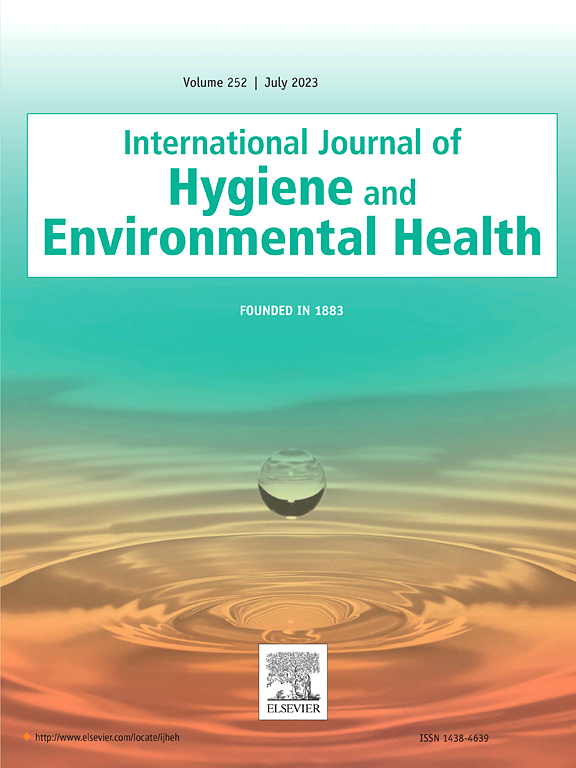Sewer transport conditions and their role in the decay of endogenous SARS-CoV-2 and pepper mild mottle virus from source to collection
IF 4.5
2区 医学
Q1 INFECTIOUS DISEASES
International journal of hygiene and environmental health
Pub Date : 2024-10-07
DOI:10.1016/j.ijheh.2024.114477
引用次数: 0
Abstract
This study presents a comprehensive analysis of the decay patterns of endogenous SARS-CoV-2 and Pepper mild mottle virus (PMMoV) within wastewaters spiked with stool from infected patients expressing COVID-19 symptoms, and hence explores the decay of endogenous SARS-CoV-2 and PMMoV targets in wastewaters from source to collection of the sample. Stool samples from infected patients were used as endogenous viral material to more accurately mirror real-world decay processes compared to more traditionally used lab-propagated spike-ins. As such, this study includes data on early decay stages of endogenous viral targets in wastewaters that are typically overlooked when performing decay studies on wastewaters harvested from wastewater treatment plants that contain already-degraded endogenous material. The two distinct sewer transport conditions of dynamic suspended sewer transport and bed and near-bed sewer transport were simulated in this study at temperatures of 4 °C, 12 °C and 20 °C to elucidate decay under these two dominant transport conditions within wastewater infrastructure. The dynamic suspended sewer transport was simulated over 35 h, representing typical flow conditions, whereas bed and near-bed transport extended to 60 days to reflect the prolonged settling of solids in sewer systems during reduced flow periods. In dynamic suspended sewer transport, no decay was observed for SARS-CoV-2, PMMoV, or total RNA over the 35-h period, and temperature ranging from 4 °C to 20 °C had no noticeable effect. Conversely, experiments simulating bed and near-bed transport conditions revealed significant decreases in SARS-CoV-2 and total RNA concentrations by day 2, and PMMoV concentrations by day 3. Only PMMoV exhibited a clear trend of increasing decay constant with higher temperatures, suggesting that while temperature influences decay dynamics, its impact may be less significant than previously assumed, particularly for endogenous RNA that is bound to dissolved organic matter in wastewater. First order decay models were inadequate for accurately fitting decay curves of SARS-CoV-2, PMMoV, and total RNA in bed and near-bed transport conditions. F-tests confirmed the superior fit of the two-phase decay model compared to first order decay models across temperatures of 4 °C–20 °C. Finally, and most importantly, total RNA normalization emerged as an appropriate approach for correcting the time decay of SARS-CoV-2 exposed to bed and near-bed transport conditions. These findings highlight the importance of considering decay from the point of entry in the sewers, sewer transport conditions, and normalization strategies when assessing and modelling the impact of viral decay rates in wastewater systems. This study also emphasizes the need for ongoing research into the diverse and multifaceted factors that influence these decay rates, which is crucial for accurate public health monitoring and response strategies.
下水道运输条件及其在内源性 SARS-CoV-2 和辣椒轻微斑驳病毒从源头到采集过程中的衰变作用。
本研究全面分析了内源性 SARS-CoV-2 和花椒轻微斑驳病毒(PMMoV)在添加有 COVID-19 症状的感染者粪便的废水中的衰变模式,从而探索了废水中内源性 SARS-CoV-2 和 PMMoV 目标物从源头到样本采集的衰变过程。与传统上使用的实验室繁殖尖峰蛋白相比,本研究使用感染患者的粪便样本作为内源性病毒材料,以更准确地反映真实世界的衰变过程。因此,本研究包含了废水中内源性病毒目标早期衰变阶段的数据,而这些数据在对污水处理厂收集的废水进行衰变研究时通常会被忽略,因为废水中含有已经降解的内源性物质。本研究模拟了动态悬浮下水道传输以及床层和近床层下水道传输这两种不同的下水道传输条件,温度分别为 4°C、12°C 和 20°C,以阐明这两种主要传输条件在废水基础设施中的衰变情况。动态悬浮下水道传输模拟时间为 35 小时,代表典型的流量条件,而下水道床面和近床面传输则延长至 60 天,以反映流量减少期间下水道系统中固体的长期沉淀。在动态悬浮污水传输过程中,SARS-CoV-2、PMMoV 或总 RNA 在 35 小时内没有衰减,温度从 4 °C 到 20 °C 也没有明显影响。相反,模拟床面和近床运输条件的实验显示,到第 2 天,SARS-CoV-2 和总 RNA 浓度显著下降,到第 3 天,PMMoV 浓度显著下降。只有 PMMoV 表现出明显的衰变常数随温度升高而增加的趋势,这表明虽然温度会影响衰变动力学,但其影响可能没有以前假设的那么大,特别是对于与废水中溶解的有机物结合的内源性 RNA。一阶衰变模型不足以准确拟合 SARS-CoV-2、PMMoV 和总 RNA 在床层和近床传输条件下的衰变曲线。F 检验证实,与一阶衰变模型相比,两相衰变模型在 4 °C-20 °C 温度范围内的拟合效果更好。最后,也是最重要的一点是,总 RNA 归一化是校正 SARS-CoV-2 暴露于床面和近床面迁移条件下的时间衰减的适当方法。这些研究结果突出表明,在评估和模拟污水系统中病毒衰变率的影响时,考虑从进入下水道开始的衰变、下水道传输条件和归一化策略非常重要。这项研究还强调了对影响这些衰变率的各种多方面因素进行持续研究的必要性,这对准确的公共卫生监测和应对策略至关重要。
本文章由计算机程序翻译,如有差异,请以英文原文为准。
求助全文
约1分钟内获得全文
求助全文
来源期刊
CiteScore
11.50
自引率
5.00%
发文量
151
审稿时长
22 days
期刊介绍:
The International Journal of Hygiene and Environmental Health serves as a multidisciplinary forum for original reports on exposure assessment and the reactions to and consequences of human exposure to the biological, chemical, and physical environment. Research reports, short communications, reviews, scientific comments, technical notes, and editorials will be peer-reviewed before acceptance for publication. Priority will be given to articles on epidemiological aspects of environmental toxicology, health risk assessments, susceptible (sub) populations, sanitation and clean water, human biomonitoring, environmental medicine, and public health aspects of exposure-related outcomes.

 求助内容:
求助内容: 应助结果提醒方式:
应助结果提醒方式:


